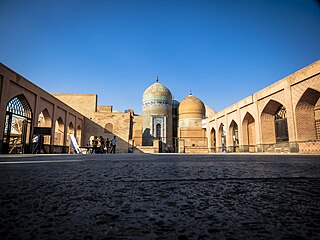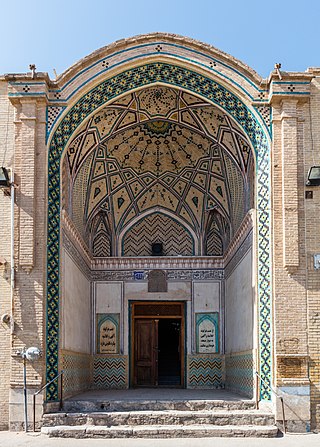
The Shah Mosque is a mosque located in Isfahan, Iran. It is located on the south side of Naghsh-e Jahan Square. It was built during the Safavid Empire under the order of Abbas the Great.

Sheikh Lotfollah Mosque is one of the masterpieces of Iranian architecture that was built during the Safavid Empire, standing on the eastern side of Naqsh-i Jahan Square, Esfahan, Iran. Construction of the mosque started in 1603 and was finished in 1619. It was built by the chief architect Mohammadreza Isfahani, during the reign of Shah Abbas I of Persia. On the advice of Arthur Upham Pope, Reza Shah Pahlavi had the mosque rebuilt and repaired in the 1920s.
Traditional Persian residential architecture is the architecture employed by builders and craftsmen in Greater Iran and the surrounding regions influenced by Persian culture to construct vernacular houses. The art draws from various eras and elements of Persia.

The Blue Mosque is a historic mosque in Tabriz, Iran. The construction for Blue Mosque, also known as Masjed-e Moẓaffariya, started during the rule of the Qarā Qoyunlu dynasty (1351–1469) and was completed in 1465 during the reign of the Āq Qoyunlu The famous Blue Mosque is widely recognized as the last remaining example of Turkmen architectural and decorative styles in the city. The features of Blue Mosque prompted the scholars to explore the innovative features of Tabriz's ceramic tile craftsmanship—highlighting its distinctive "blue-and-white" patterns, lusterware, and gilded cobalt tiles, which for a considerable time were recognized as the sole known example of their kind.

The Jāmeh Mosque of Isfahān or Jāme' Mosque of Isfahān, also known as the Atiq Mosque and the Friday Mosque of Isfahān, is a historic congregational mosque (Jāmeh) of Isfahan, Iran. The mosque is the result of continual construction, reconstruction, additions and renovations on the site from around 771 to the end of the 20th century. The Grand Bazaar of Isfahan can be found towards the southwest wing of the mosque. It has been a UNESCO World Heritage Site since 2012. It is one of the largest and most important monuments of Islamic architecture in Iran.

Jameh Mosque of Atigh is a 9th-century mosque in Shiraz, the capital of Fars Province, Iran, Atigh Jameh mosque the oldest mosque of Shiraz was built in celebration of the conquest of Shiraz by Saffarid Amroleiss in the year 276 AH and was completed in 281 AH. It has been restored many times. The height of the building and its various nocturnal areas (Shabestans) with beautiful tile work on the ceilings, gives a unique charm to this place. It is located in the east of Shah Cheragh Shrine. The entrance door of Shah Cheragh is on the west side of the mosque. undefined Atiq Jame Mosque of Shiraz has been renovated several times. Nodbeh Wall and Khodaye Khane are some of the attractions of this mosque. Additionally, the dome of the north Iwan and the hypostyle columns are so attracting. In the southern part of this mosque, there is a wall called “Nodbeh”. It differentiates from other walls with a picture of colorful cedar on it. It is believed that on the night of Miraj, Boragh /Buraqpassed from this (Nodbeh) Wall. There is an Iwan and Shabestan. Shabestan is an underground space that can be usually found in the traditional architecture of mosques, houses, and schools in ancient Iran. These spaces were usually used during summers and could be ventilated by windcatchers and qanats. North side is also known as “Imam Gate”. North gate is decorated with Mogharnas tiles.

Sheikh Safi al-Din Khānegāh and Shrine Ensemble is the tomb of Sheikh Safi-ad-din Ardabili located in Ardabil, Iran. In 2010, it was registered on the UNESCO World Heritage List.

The Ganjali Khan Complex is a Safavid-era building complex, located in the old center of city of Kerman, Iran. The complex is composed of a school, a square, a caravanserai, a bathhouse (hammam), an Ab Anbar, a mint, a mosque and a bazaar.

The Sultan al-Ghuri Complex or Funerary complex of Sultan al-Ghuri, also known as al-Ghuriya, is a monumental Islamic religious and funerary complex built by the Mamluk sultan Qansuh al-Ghuri between 1503 and 1505 CE. The complex consists of two major buildings facing each other on al-Mu'izz li-Din Allah street, in the Fahhamin Quarter, in the middle of the historic part of Cairo, Egypt. The eastern side of the complex includes the Sultan's mausoleum, a khanqah, a sabil, and a kuttab, while the western side of the complex is a mosque and madrasa. Today the mosque-madrasa is still open as a mosque while the khanqah-mausoleum is open to visitors as a historic site.

Jāmeh Mosque of Varāmīn, Congregation mosque of Varamin, Friday mosque of Varamin or Grand mosque of Varamin is the grand congregational mosque of Varamin in the Tehran province of Iran. This mosque is one of the oldest buildings of Varamin city. Its construction began during the reign of Sultan Mohammad Khodabaneh and was completed during his son's, Abu Sa'id Bahadur Khan, rule in 1322. This building consists of a shabestan, portico, large brick dome, the structure beside shabestan and ten small arches along with one large arch in the middle.
The Agha Nour mosque is a mosque located in Isfahan, Iran. It was founded during the Shah Abbas I era and completed during the Shah Safi era, and as such the names of both kings were mentioned in the inscription above the portal of the mosque. The mosque was built under the supervision of Noureddin Mohammad Esfahani, who was one of the richest men in Isfahan. The Shabestan of this mosque is one of the most beautiful Shabestans in Isfahan. This Shabestan has stone pillars with marble arches, which provide light during the day.

Rahim Khan Mosque is a historical mosque in Isfahan, Iran. It was built in the late 19th century. This mosque has an unusual combination of styles in architectural decorations. The shabestan of this mosque is one of the biggest shabestans in Isfahan. The shabestan, portal, iwan and outer surface of the mosque's dome have been rebuilt.
Saint Mary Church of New Julfa is a historical Armenian church in Isfahan, Iran, completed in 1613.

The Barsian mosque and minaret are historical structures in the Isfahan province. Barsian, which was originally Parsian in the past, is a village located 42 km east of Isfahan. According to the inscriptions the mosque was built in 1105 and the minaret was built in 1098 in the era of Barkiyaruq, the Seljuq king. The minaret is the fourth oldest minaret in Iran, which has an inscription. It is 34 m high. Its bottom part has simple bricks, but the upper parts have been decorated by decorative bricks.

The Jameh mosque of Kashan is the oldest historical structure in Kashan, Iran. Its only brick minaret is located in its southeastern corner. On the bottom part of the minaret, there is a kufic inscription made by embossed brick. On the inscription, it is mentioned the construction date of the minaret, which is 1074 AD. The minaret is the third oldest minaret in Iran, which has an inscription.
The Meydan Mosque is a historical mosque in Kashan, Iran. It is located in the southern side of the Sang-e Ghadimi square and beside the Bazaar of Kashan. It is one of the oldest structures in Kashan. The primary structure belonged possibly to the seljuq era, but it was destroyed by the Mongols during their invasions. Later it was rebuilt and repaired by Khaje Emad ed-Din. A quotation for this matter is an inscription in the old mihrab, in which it is mentioned that it is built in 623 Hijri by Hassan ebn-e Arabschah in Kashan. The mihrab was in its original place until the last century, but it is kept now in the Museum of Islamic art in Berlin.

Persian domes or Iranian domes have an ancient origin and a history extending to the modern era. The use of domes in ancient Mesopotamia was carried forward through a succession of empires in the Greater Iran region.
Mohammad Reza Emami was a Persian calligrapher in the 17th century. He lived from the era of Abbas I until the era of Suleiman I. He was Ali Reza Abbassi's student and was known as the Imam of calligraphers.

Deir-e Gachin Caravansarai is a historic caravansarai in Iran, located in the center of Kavir National Park. Due to its historical significance and unique features, it is sometimes called the "Mother of Iranian Caravanserais." Situated in the Central District of Qom County, it lies 80 kilometers northeast of Qom and 35 kilometers southwest of Varamin. This monument was added to Iran's National Heritage List on September 23, 2003.

The Jameh Mosque of Natanz is located in the city of Natanz, Isfahan province. It dates back to the Mongol Ilkhanid period and was first constructed during the reign of the Mongol ruler Öljaitü. The structure is a complex comprising a mosque, a khanqah and the tomb of Abdul Samad al-Isfahani, a prominent Sufi ascetic.
















